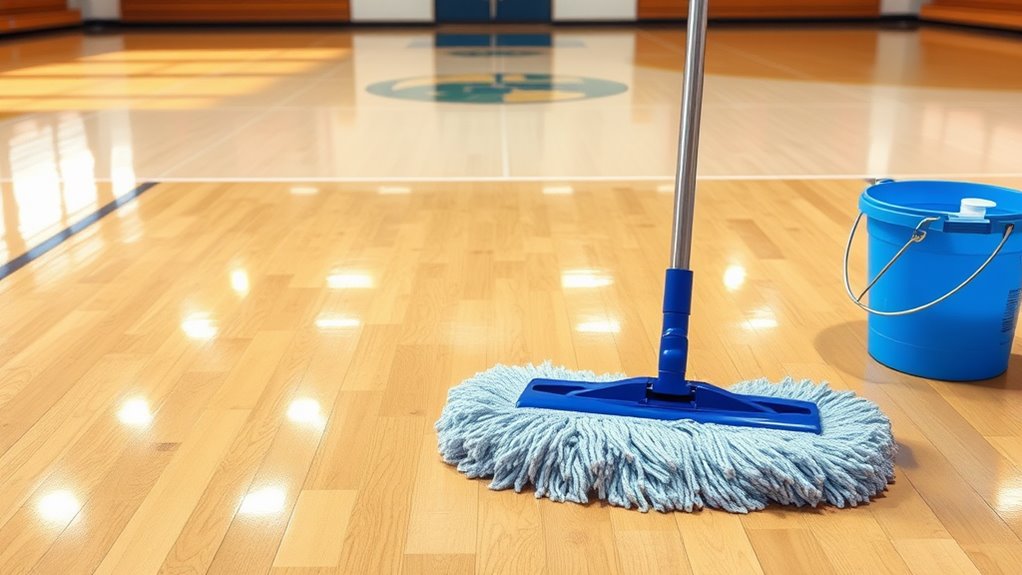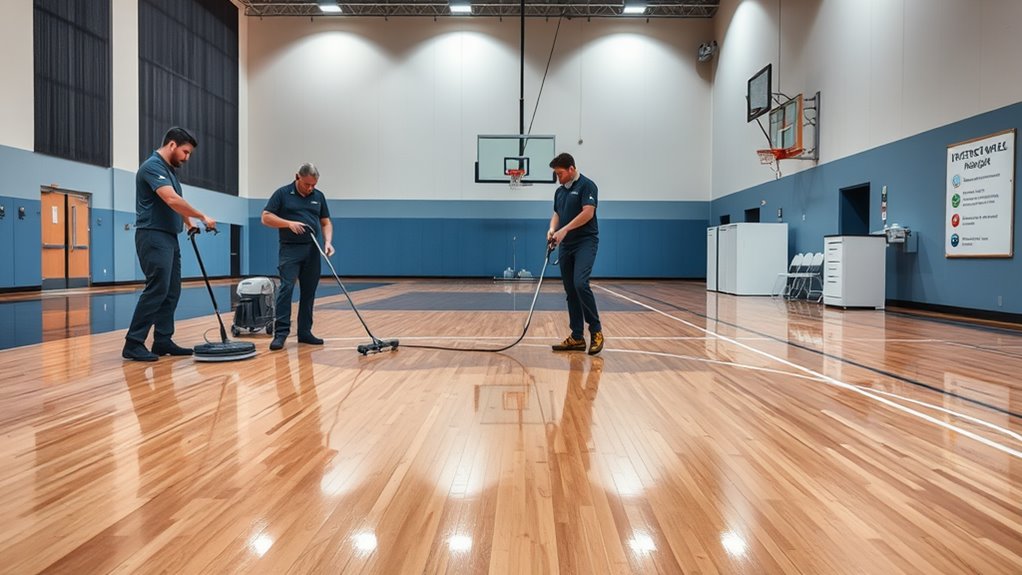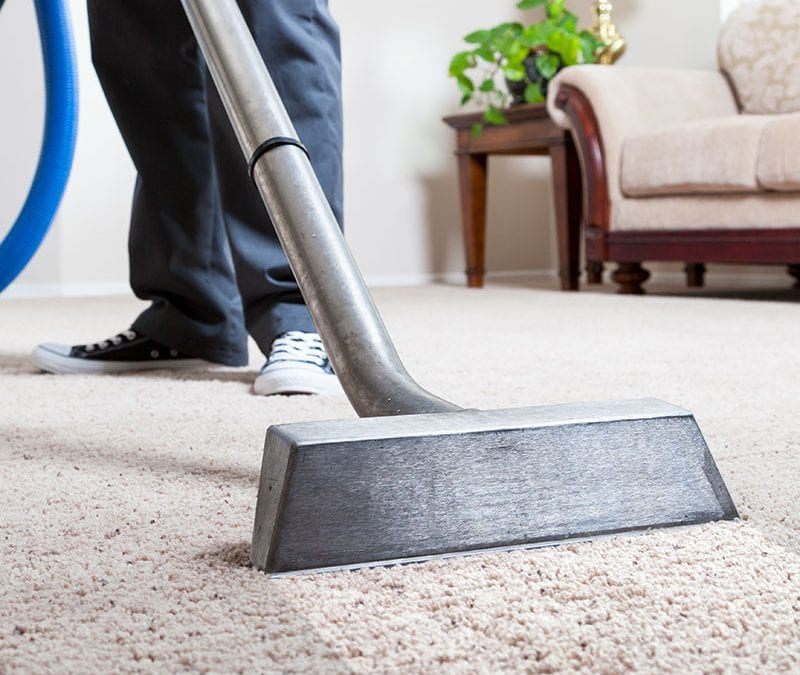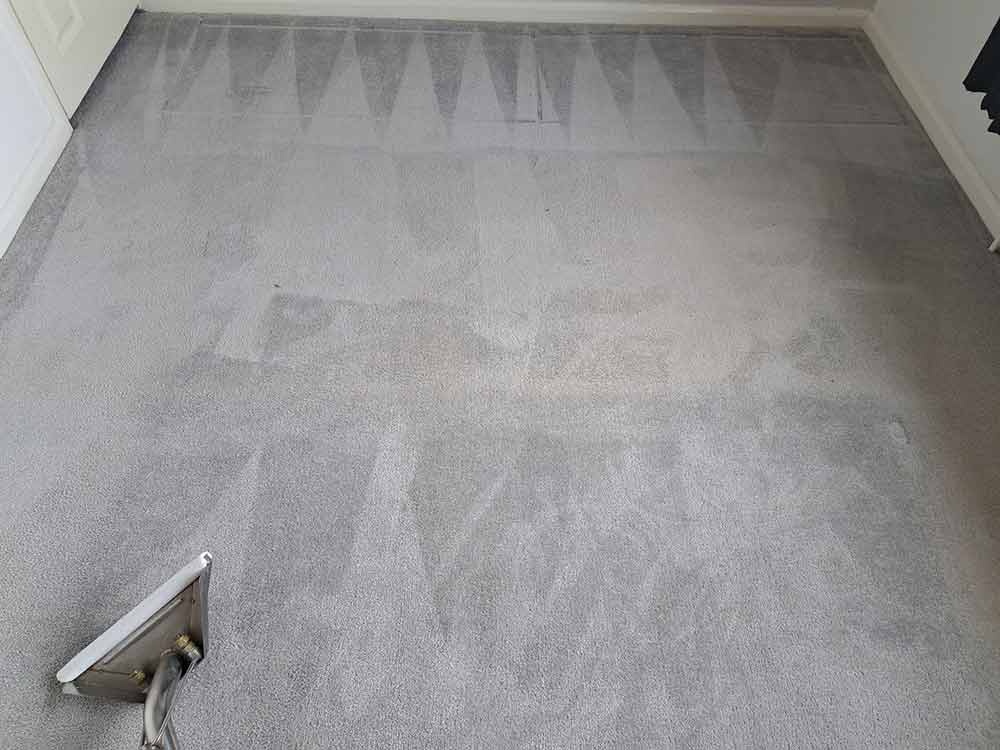Imagine stepping onto a gym floor that feels like a pristine canvas, ready for every workout masterpiece. You know clean floors aren't just about appearances; they're essential for health and safety. Before you can create that inviting space, you need to understand the best practices for cleaning and disinfecting. From choosing the right products to mastering effective techniques, each step plays a significant role in maintaining an appealing environment. So, what's the first move you should make to guarantee your gym floors stand out for all the right reasons?
Importance of Clean Gym Floors
Clean gym floors are essential for maintaining a healthy and safe workout environment. You should be aware that gym floors can harbor over 1 million germs per square inch, including harmful bacteria like Staphylococcus aureus and MRSA.
Regular cleaning and disinfection are important to prevent the spread of infections and illnesses, such as fungal infections like ringworm and athlete's foot. Ignoring this can elevate health risks, as up to 30% of gym surfaces may contain bacteria that lead to illness or skin infections.
Additionally, it's important to remove sweat and moisture to prevent mold and mildew. A clean floor not only enhances safety but also contributes greatly to user satisfaction.
A well-maintained gym floor creates a visually appealing environment, fostering a positive experience for all users. By prioritizing cleanliness, you reflect professionalism and attention to detail, which can enhance your gym's reputation.
Preparation and Initial Steps
Before diving into the cleaning process, it's crucial to prepare the gym floor properly to guarantee an effective and thorough clean. Start by ensuring the area is clear of any equipment or obstacles, which allows for unhindered access to every corner of the floor.
Next, use appropriate cleaning tools to remove loose dirt and debris; a broom or vacuum with a soft beater brush will work well.
Follow these initial preparation steps:
- Inspect for Residues: Check for any sticky residues and remove them gently with a soft plastic scraper.
- Remove Gum: Freeze any gum with ice, then scrape it off carefully.
- Protect the Floor: Use a soft-bristled brush or microfiber mop to avoid scratching the surface during cleaning.
Once the area is prepared, you can proceed with creating your cleaning solution.
Selecting Cleaning Products
When it comes to maintaining a pristine gym environment, selecting the right cleaning products is crucial for both the longevity of your floors and the health of your patrons.
Begin by opting for pH-neutral cleaners, which are safe for wood, rubber, and vinyl surfaces. Avoid overly acidic or alkaline products, as these can damage finishes. A mild liquid dish detergent or a neutral pH cleanser works well for daily dirt removal.
Consider concentrated cleaners for their cost-effectiveness and sustainability. Use 1–2 oz. per gallon for mopping and 10 oz. for autoscrubbers on rubber flooring. Always adhere to the manufacturer's dilution recommendations to prevent damage.
Non-toxic, low-VOC products are essential for health, so steer clear of harsh chemicals like bleach or vinegar. Instead, select environmentally friendly options that are specifically designed for gym flooring.
Verify efficacy by using EPA-registered disinfectants that tackle a broad spectrum of germs. Regularly review your product selection and cleaning frequency, adapting protocols as necessary to maintain safety and effectiveness.
Training your staff on proper usage further guarantees that cleaning practices are both safe and efficient.
Effective Cleaning Techniques
To guarantee gym floors remain in top condition, effective cleaning techniques are essential. Start by preparing the area: sweep or vacuum to remove loose dirt and debris, making sure you use a vacuum without a beater brush to avoid scratches. Overlap your vacuum strokes for thorough coverage.
Next, employ deep cleaning methods. Prepare a diluted cleaning solution per the manufacturer's instructions. Use microfiber mopping, working in sections while wringing out the mop to control moisture. Rinse frequently and allow the floor to air dry or use a dry mop to expedite the process.
Finally, integrate proper disinfectant application. Use EPA-registered disinfectants specifically designed for gym floors, making certain the surface remains wet for the recommended contact time. Regularly disinfect high-traffic areas and train your staff in these practices to maintain a safe environment.
Remember these key points for effective cleaning:
- Microfiber Mopping: Essential for effective dirt removal without damage.
- Dilute Cleaning Solution: Follow manufacturer instructions to guarantee efficacy.
- Regular Disinfection: Daily routines prevent the buildup of germs and bacteria.
Stain and Damage Solutions

Even with effective cleaning techniques in place, gyms can still face challenges with stains and damage on their floors. To tackle these issues, start by identifying and treating specific stains. For sweat stains, use a pH-neutral cleaner with a soft cloth, while dirt or mud can be managed by vacuuming and mopping with an appropriate solution.
For tougher stains like gum or blood, employing advanced cleaning methods like freezing the gum or using a mild detergent will prove effective.
When it comes to damage, address water damage by drying the surface and identifying the source. For minor issues, sanding may suffice, but severe cases might necessitate replacement.
Repair loose or cracked boards during refinishing, and for scratches or dents, sand the area and recoat the surface.
To prevent future stains and damage, implement stain prevention tips such as avoiding water soakage and using protective covers.
Regular cleaning and proper disinfection are essential to maintain a hygienic environment. By training your staff in these techniques, you'll guarantee your gym floors remain in top condition for all users.
Regular Maintenance Practices
How can you guarantee your gym floors remain in ideal condition? Regular maintenance practices are essential for achieving damage prevention and ensuring your floors are safe and visually appealing.
Implementing a systematic routine will help you identify issues early and keep your gym in top shape.
Consider the following key practices:
- Daily Cleaning: Use microfiber mops and neutral cleaners tailored to your floor type while dust-mopping to remove particulate soil.
- Weekly Cleaning: Chemically clean wooden floors and disinfect high-traffic areas to prevent bacterial buildup.
- Regular Inspections: Conduct thorough floor inspections to catch wear and tear early, ensuring moisture and water damage are addressed promptly.
Staff Training and Protocols

Effective staff training and protocols are vital for maintaining a clean and safe gym environment. You'll want to guarantee that all employees understand the importance of personal hygiene and the correct use of disinfectants.
Start by training your staff on the safe application of EPA-approved intermediate-level disinfectants, emphasizing "wet time" and the necessity of personal protective equipment (PPE).
Make certain each employee knows where to locate the Safety Data Sheets (SDS) for each cleaning product, as this knowledge is essential in emergencies. Regular training sessions should be scheduled to keep staff updated on the latest cleaning protocols and to reinforce the differences between sanitizing and disinfecting surfaces and equipment.
Establish and maintain documentation of all cleaning and disinfection procedures for accountability. Create cleaning schedules that outline daily, weekly, and monthly tasks, with a focus on high-touch areas like handrails and equipment.
Train your staff to recognize the need for emergency cleaning and how to tackle various flooring types, guaranteeing a thorough disinfection process. Regular audits will help affirm compliance and maintain high standards of employee hygiene and disinfectant usage throughout your facility.
Frequently Asked Questions
How Often Should Gym Floors Be Professionally Cleaned?
You should schedule professional services for gym floors at least once a month for deep cleaning, while maintaining a consistent cleaning frequency daily. This approach guarantees a hygienic environment, prolongs floor life, and enhances aesthetics.
What Equipment Is Best for Cleaning Rubber Gym Floors?
For rubber floor maintenance, use a vacuum with a soft beater brush, microfiber mop, and pH-neutral cleaning solutions. Soft scrub brushes help with stubborn stains, ensuring effective cleaning without damaging your gym floors.
Can I Use Vinegar for Cleaning Gym Floors?
You can use vinegar for cleaning gym floors, but make certain you dilute it for effectiveness while prioritizing gym floor safety. Always test a small area first and rinse thoroughly to prevent any damage.
How Do I Handle Allergy Concerns During Cleaning?
To handle allergy concerns during cleaning, use allergy-friendly products and adjust cleaning schedules to low-traffic times. Always identify allergens, wear protective gear, and guarantee proper ventilation to minimize exposure for everyone involved.
What Should I Do if a Floor Finish Is Damaged?
If your floor's finish is damaged, assess the extent first. Following maintenance tips, clean the area, fill scratches, and apply a matching finish. Consider professional floor repair for extensive damage to guarantee lasting results.
Conclusion
By following these best practices for cleaning and disinfecting gym floors, you guarantee a safe and welcoming environment for your members. For instance, a Nottingham gym that implemented daily cleaning and weekly deep cleans saw a 30% reduction in reported injuries related to slips and falls. Maintaining clean floors not only enhances safety but also boosts member satisfaction and retention. Stay proactive in your cleaning efforts, and your gym will thrive as a healthier space for fitness enthusiasts.



